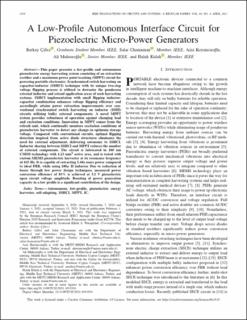| dc.contributor.author | Ciftci, Berkay | |
| dc.contributor.author | Chamanian, Salar | |
| dc.contributor.author | Koyuncuoglu, Aziz | |
| dc.contributor.author | Muhtaroglu, Ali | |
| dc.contributor.author | Külah, Haluk | |
| dc.date.accessioned | 2023-02-08T08:11:30Z | |
| dc.date.available | 2023-02-08T08:11:30Z | |
| dc.date.created | 2022-11-27T14:02:48Z | |
| dc.date.issued | 2021-02-01 | |
| dc.identifier.citation | IEEE Transactions on Circuits and Systems I: Regular Papers. 2021, 68 (4), 1458-1471. | en_US |
| dc.identifier.issn | 1549-8328 | |
| dc.identifier.issn | 1558-0806 | |
| dc.identifier.uri | https://hdl.handle.net/11250/3049092 | |
| dc.description.abstract | This paper presents a low-profile and autonomous piezoelectric energy harvesting system consisting of an extraction rectifier and a maximum power point tracking (MPPT) circuit for powering portable electronics. Synchronized switch harvesting on capacitor-inductor (SSHCI) technique with its unique two-step voltage flipping process is utilized to downsize the ponderous external inductor and extend application areas of such harvesting systems. SSHCI implementation with small flipping inductor-capacitor combination enhances voltage flipping efficiency and accordingly attains power extraction improvements over conventional synchronized switch harvesting on inductor (SSHI) circuits utilizing bulky external components. A novel MPPT system provides robustness of operation against changing load and excitation conditions. Innovation in MPPT comes from the refresh unit, which continually monitors excitation conditions of piezoelectric harvester to detect any change in optimum storage voltage. Compared with conventional circuits, optimal flipping detection inspired from active diode structures eliminates the need for external adjustment, delivering autonomy to SSHCI. Inductor sharing between SSHCI and MPPT reduces the number of external components. The circuit is fabricated in 180 nm CMOS technology with 1.23 mm2 active area, and is tested with custom MEMS piezoelectric harvester at its resonance frequency of 415 Hz. It is capable of extracting 5.44x more power compared to ideal FBR, while using 100µ H inductor. Due to reduction of losses through low power design techniques, measured power conversion efficiency of 83% is achieved at 3.2 V piezoelectric open circuit voltage amplitude. Boosting of power generation capacity in a low profile is a significant contribution of the design. | en_US |
| dc.language.iso | eng | en_US |
| dc.publisher | Institute of Electrical and Electronics Engineers (IEEE) | en_US |
| dc.relation.ispartofseries | IEEE Transactions on Circuits and Systems I: Regular Papers;Volume: 68, Issue: 4 | |
| dc.rights | Navngivelse 4.0 Internasjonal | * |
| dc.rights.uri | http://creativecommons.org/licenses/by/4.0/deed.no | * |
| dc.subject | Autonomous interface circuits | en_US |
| dc.subject | Low-profile energy harvesting systems | en_US |
| dc.subject | Piezoelectric energy harvester | en_US |
| dc.subject | Self-adapting | en_US |
| dc.subject | SSHCI | en_US |
| dc.subject | Synchronized switch harvesting on capacitor-inductors | en_US |
| dc.subject | MPPT | en_US |
| dc.title | A Low-Profile Autonomous Interface Circuit for Piezoelectric Micro-Power Generators | en_US |
| dc.type | Peer reviewed | en_US |
| dc.type | Journal article | en_US |
| dc.description.version | publishedVersion | en_US |
| cristin.ispublished | true | |
| cristin.fulltext | original | |
| cristin.qualitycode | 2 | |
| dc.identifier.doi | 10.1109/TCSI.2021.3053503 | |
| dc.identifier.cristin | 2081783 | |
| dc.source.journal | IEEE Transactions on Circuits and Systems I: Regular Papers | en_US |
| dc.source.volume | 68 | en_US |
| dc.source.issue | 4 | en_US |
| dc.source.pagenumber | 1458-1471 | en_US |

